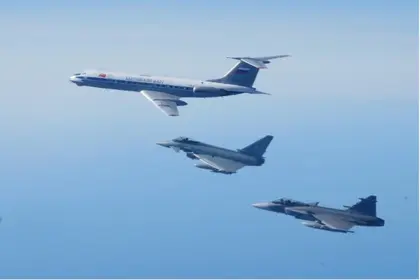As Sweden’s flag was being raised outside NATO Headquarters on Monday to mark its accession as the Alliance’s 32nd member, its aircraft were being scrambled as part of the quick reaction alert system over the Baltic Sea.
On the morning of March 11, Allied radar operators detected an unidentified, undeclared aircraft track over the Baltic Sea traveling from Kaliningrad towards mainland Russia. The controllers at NATO’s Combined Air Operations Center (CAOC) in Uedem, Germany coordinated the launch of Swedish JAS-39 Gripen multi-role fighter aircraft assigned to NATO, as well as Belgian F-16AM fighter aircraft from Šiauliai Air Base, Lithuania. The aircraft made a visual identification of a Russian Tupolev Tu-134 “Crusty” military airliner.
Later that day, NATO’s CAOC alerted the German Quick Reaction Alert base at Lielvarde, Latvia after another track was spotted over the Baltic. Germany launched Luftwaffe Eurofighters and Sweden again sent its JAS-39 Gripens in support.
On this occasion, the track was from Russian Aerospace Forces (VKS) Antonov An-26 “Cash” transport aircraft.
This first real-world mission of Swedish aircraft occurred only days after the nation had become a NATO member.
NATO’s Allied Air Command described the mission as “an impressive demonstration of the deep integration the Swedish Air Force has achieved with NATO Air Policing forces and the close and smooth interoperability in support of safeguarding NATO over the Baltic Sea.”

Europe Should Be Afraid if Putin Accepts US-Proposed Peace Plan
Allied fighter jets are regularly scrambled to intercept, identify and track Russian planes flying in international airspace near NATO territory over the Baltic Sea and other sensitive areas. For the Germans, this operation was the second such mission since taking over the Air Policing mission at Lielvarde on March 1, while Belgian jets have been scrambled around a dozen times since beginning their mission at Šiauliai on Dec. 1.
On Tuesday, Russia again “exercised its right” to perform scheduled flights over the international waters of the Baltic and Caspian seas. On this occasion it used a more aggressive mix of aircraft: Tu-22M3 long-range bombers and a MiG-31 fighter armed with the Kinzhal ballistic system by Su-30SM and Su-35S escort fighters, according to a statement by the Russian Defense Ministry.
The statement said that “long-range aircraft of the Russian Aerospace Forces have performed scheduled flights over the international waters of the Baltic and Caspian seas.”
It added that the mission “involved Tu-22M3 long-range bombers and MiG-31 fighters armed with the Kinzhal air-launched system” and that “the crews of MiG-31 aircraft practiced in-flight refueling.”
The commander of Russia’s long-range aviation division, Lieutenant-General Sergey Kobylash, said: “All flights were carried out in strict compliance with international rules of using airspace. Long-range aviation pilots regularly fly over the international waters of the Arctic, North Atlantic, Black and Baltic seas, and the Pacific Ocean.”.
Commenting on the fact that, once again, NATO aircraft including Swedish Gripens had observed the Russian aircraft, Kobylash said: “At some stages of the route our airplanes were accompanied by fighter jets from other countries.”
You can also highlight the text and press Ctrl + Enter






